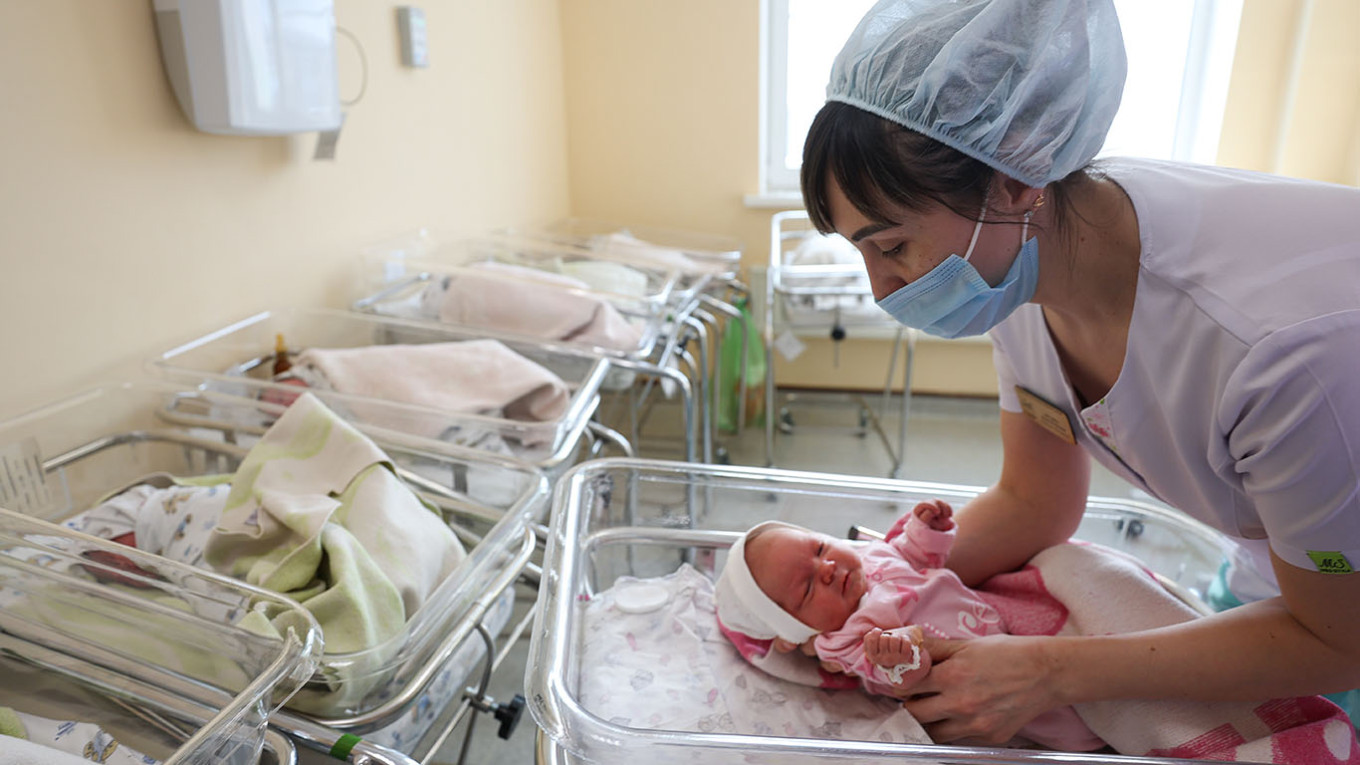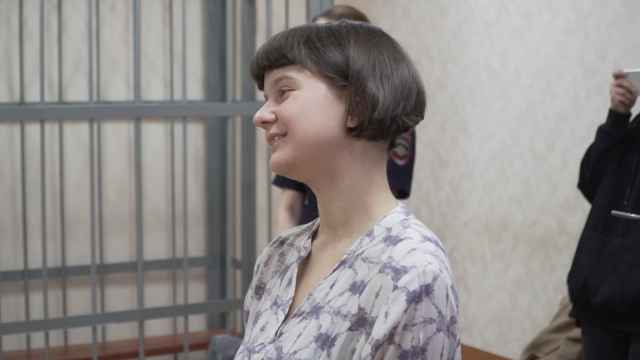Earlier this month, President Vladimir Putin said that “support for families” and stimulating birth rates were “the most important” of all of Russia’s national projects and strategic plans.
“Fatherhood and motherhood are happiness, and happiness should not be postponed,” Putin said at a meeting of the presidential council on Russia’s demographics.
Russian officials, who have repeatedly described its demographics and “very low” birth rate as a serious concern, are intensifying their efforts to encourage citizens to have more children.
Yet despite officials’ best efforts, experts say the current demographic situation in Russia should be viewed as a deep crisis.
The Moscow Times looks at how nearly four years of war with Ukraine, state policies and economic realities are shaping Russia’s demographics and how the situation differs across the country’s regions.
What are Russia’s demographic figures?
Russia’s birth rate is at one of its lowest points in its modern history.
The country’s total fertility rate — the average number of children a woman is expected to have in her lifetime — stands at around 1.41, according to the state statistics agency Rosstat.
This is below the level required for population replacement, meaning each new generation of Russian citizens is smaller than their parents’ generation.
For example, in 2024, Russia’s natural population decline — the number of deaths minus the number of births — totaled 596,200 people. The total number of births that year fell to 1.22 million, a 3.4% decrease from 1.27 million the previous year. The only time this figure was lower was in 1999, when the number of newborns dropped to 1.21 million.
Low birth rates eventually lead to population decline and aging as fewer children are born, leading to labor shortages, slower economic growth and higher spending on pensions and healthcare.
In Russia’s case, these effects have yet to fully take hold, independent demographer Alexei Raksha noted.
In general, Russia’s position mirrors broader global trends in declining fertility. The total fertility rate stood at 1.38 live births per woman in the EU in 2023, while in the United States it stood at 1.59 in 2024.
Regional differences
While the nationwide birth rate is declining, fertility levels can vary from region to region.
Last year, Putin introduced the total fertility rate as a benchmark for evaluating governors’ performance.
The republic of Chechnya (2.7), the republic of Tuva (2.3), the Yamal-Nenets autonomous district (1.9), the republic of Altai (1.8) and the republic of Ingushetia (1.8) boast the highest birth rates in the country.
These leading regions display different fertility patterns. In the North Caucasus republics of Chechnya and Ingushetia, high birth rates are largely driven by large families, more conservative cultural norms and the practice of Islam, experts said.
Raksha also noted that Tuva’s high birth rates are accompanied by another indicator: a large number of underage mothers. In 2023, the Far East republic recorded a Russia-wide record of 9.5 births per 1,000 girls aged 15 to 17, Raksha said.
According to experts, 33 regions, mostly in the Central and Northwest Federal Districts, have very low fertility rates (below 1.3). The lowest fertility rates in 2024 were recorded in Leningrad region (0.89), Mordovia (0.99) and in the annexed city of Sevastopol (1.0).
Government efforts
Russian authorities have introduced a wide range of programs to encourage families to have more children in recent years.
Yet despite government programs, raising the fertility rate in Russia now is likely unrealistic “amid a prolonged military conflict, sanctions pressure, international isolation and the serious economic problems caused by these factors,” expert Salavat Abylkalikov told The Moscow Times.
One of the central measures is the maternity capital program, which provides families with lump-sum payments for the birth of their first and second child, as well as for subsequent children. Mothers can now receive one-time payments of between 690,266 and 912,162 rubles ($8,700-$11,500) for giving birth.
In addition to this, the state offers various allowances for families with children and monthly payments for pregnant women who register for prenatal care.
Authorities have also expanded housing support, offering preferential mortgage programs and other benefits to large families, including proposals for discounted car loans and tax relief programs that increase as the number of children grows.
Behind the financial incentives stands a robust state campaign of promoting so-called traditional values and family ideals that has intensified in recent years, with Russian authorities drawing a contrast with what they describe as Western degeneracy.
One of the most debated recent measures has been a law introducing heavy fines for what authorities describe as the harmful promotion of “childfree ideology.”
At least 27 Russian regions have also introduced fines for “encouraging abortions,” which covers any attempt to influence a woman to have an abortion, as well as providing any information about abortion can result in administrative liability.
Abylkalikov described initiatives to promote “traditional values” as being “ineffective,” but said they “require little financial investment, making them convenient for creating the appearance of active policymaking.”
For example, the number of abortions was already declining rapidly and continued to fall throughout the post-Soviet period, Abylkalikov noted.
According to Raksha, the measures to boost the birth rate being implemented in Russia often appear to be little more than a “formality” to show that the government is taking action.
“What is really needed are large-scale investments in genuine family support, better childcare infrastructure and opportunities to combine motherhood with a career,” expert Abylkalikov told The Moscow Times.
So far, government programs "mainly influence the ‘timing of births’ — encouraging families to have children earlier than planned — but have little effect on the total number of children a family intends to have,” Abylkalikov said.
The impact of the war
Experts are divided on how the war has affected birth rates.
According to Raksha, the war “hasn’t had a particularly strong impact on birth rates” and has rather affected mortality. While there is an outflow of men to the front, at the same time large payments to military personnel may encourage families to have children by boosting household income, he noted.
Yet Abylkalikov said that indirectly “uncertainty and the lack of long-term planning” caused by the war and economic sanctions could suppress birth rates.
“The war, sanctions and underfunding will inevitably lead to the degradation of the healthcare system and increased social stress, which in the medium term will result in additional, excess mortality that would not occur under normal circumstances,” Abylkalikov said.
A Message from The Moscow Times:
Dear readers,
We are facing unprecedented challenges. Russia's Prosecutor General's Office has designated The Moscow Times as an "undesirable" organization, criminalizing our work and putting our staff at risk of prosecution. This follows our earlier unjust labeling as a "foreign agent."
These actions are direct attempts to silence independent journalism in Russia. The authorities claim our work "discredits the decisions of the Russian leadership." We see things differently: we strive to provide accurate, unbiased reporting on Russia.
We, the journalists of The Moscow Times, refuse to be silenced. But to continue our work, we need your help.
Your support, no matter how small, makes a world of difference. If you can, please support us monthly starting from just $2. It's quick to set up, and every contribution makes a significant impact.
By supporting The Moscow Times, you're defending open, independent journalism in the face of repression. Thank you for standing with us.
Remind me later.







